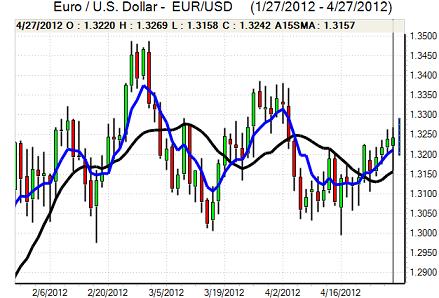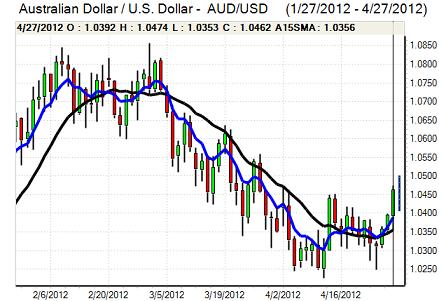EUR/USD
The Euro held support in the 1.3150 region against the dollar in early Europe on Friday and pushed higher as the lack of selling conviction helped triggered a fresh round of short covering as it moved back above the 1.32 level. There was a sharp rise in Italian yields in the latest bond auction and there was upward pressure on Spanish yields. The immediate market reaction was limited as markets had already priced in a significant increase. There were still concerns over underlying stresses within the Euro-zone, especially with political tensions continuing to increase. There was also a further increase in Spanish unemployment in the latest data and there were expectations that Monday’s GDP data would confirm recession.
Latest opinion polls continued to suggest that Socialist Party Hollande held a comfortable lead for the second round of the French Presidential election and there was further speculation that there would be an increase in tensions with German Chancellor Merkel.
The advance US GDP data was significantly weaker than expected with a figure of 2.2% from 2.6% expected and there was particular disappointment given that the market rumours were for a stronger than expected release. A slowdown in inventory growth held the economy back during the period.
The dollar failed to gain any notable support on risk-aversion grounds and yield grounds proved to be more important for the US currency as it lost ground against the majors. The evidence suggested that there was increased speculation over a further round of quantitative easing. The revised Michigan consumer confidence index edged higher to 76.4 from 75.7, although the impact was limited following the GDP data.
The Euro pushed to 3-week highs in the 1.3260 area against the dollar with further reports of institutional Euro selling above the 1.3250 level.
The latest speculative positioning data recorded a small decline in net long dollar positions with markets not moving significantly in Asia on Monday.

Source: VantagePoint Intermarket Analysis Software
Call now and you will be provided with FREE recent forecasts
that are up to 86% accurate* 800-732-5407
If you would rather have the recent forecasts sent to you, please go here
Yen
The dollar initially found support in the 80.50 region against the yen in Europe on Friday. Bank of Japan Governor Shirakawa stated that it would take time for monetary easing to take effect and warned against easing recklessly without taking time lags into effect. There will still be pressure on the central bank to relax monetary policy again if the yen is subjected to further upward pressure.
The weaker than expected US GDP data was significant in undermining the dollar and there were lows close to the 80.20 region as the US currency lost wider support. Yield factors continued to undermine the US currency in Asian trading on Monday. Japanese markets were closed for the start of the Golden Week holidays which cut liquidity and may curb underlying dollar buying with the dollar dipping to test towards the 80 level.
Sterling
Sterling was able to break above the 1.62 level against the dollar during the European morning on Friday and this was significant in triggering stop-loss UK buying, especially after the break of an option barrier.
There was further evidence of defensive Sterling demand as a refuge from the Euro-zone stresses even though the Euro itself as broadly resilient. In this context, the trade-weighted index rose to the highest level since August 2009 and the UK currency pushed to fresh 7-month highs above 1.6280 against the dollar.
The latest PMI surveys will be watched very closely this week given recent contradictory evidence. Another solid set of releases would lessen pressure on the Bank of England for additional quantitative easing. Sterling maintained a strong tone in Asian trading on Monday.
Swiss franc
The US currency was unable to make any significant headway against the franc during Friday and dipped to lows near 0.9050 before finding some degree of support. There was no additional Euro support during the day as it remained trapped near the 1.2010 level and there were further reports of National Bank intervention to prevent renewed Euro losses.
The Swiss KOF index increased to 0.40 in April from a revised 0.09 the previous month which should ease fears over the economy to some extent. National Bank Chairman Jordan reiterated that the bank maintained its commitment to preserving the 1.20 minimum level. He stated that negative interest rates were unlikely to be introduced, but that there were other policies available.

Source: VantagePoint Intermarket Analysis Software
Call now and you will be provided with FREE recent forecasts
that are up to 86% accurate* 800-732-5407
If you would rather have the recent forecasts sent to you, please go here
Australian dollar
The Australian dollar found support below 1.0380 against the US currency on Friday and pushed to challenge the 1.04 level. A break above this level helped trigger stop-loss Australian dollar buying and there was fresh support from general US vulnerability which pushed the currency to a high above 1.0450 level.
There was another sharp decline in housing sales according to the latest HIA data and inflation expectations slowed which will maintain expectations of a Reserve Bank interest rate cut this week. The currency was able to hold firm in Asia on Monday with the US dollar still generally vulnerable.



